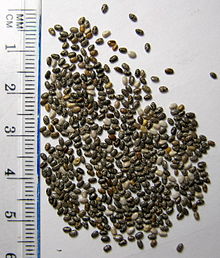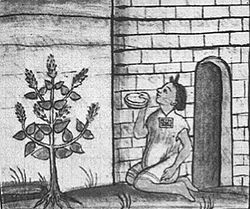- Salvia hispanica
-
Salvia hispanica Scientific classification Kingdom: Plantae (unranked): Angiosperms (unranked): Eudicots (unranked): Asterids Order: Lamiales Family: Lamiaceae Genus: Salvia Species: S. hispanica Binomial name Salvia hispanica
L., 1753[1]Salvia hispanica, commonly known as chia, is a species of flowering plant in the mint family, Lamiaceae, native to central and southern Mexico and Guatemala.[1] The 16th century Codex Mendoza provides evidence that it was cultivated by the Aztec in pre-Columbian times; it has been said that it was an important crop.[2] It is still used in Mexico and Guatemala, with the seeds sometimes ground, while whole seeds are used for nutritious drinks and as a food source.[3]
Contents
Etymology
The word chia is derived from the Nahuatl word chian, meaning oily.[1] The present Mexican state of Chiapas received its name from the Nahuatl "chia water or river."
Description
Chia is an annual herb growing to 1 m (3.3 ft) tall, with opposite leaves 4–8 cm (1.6–3.1 in) long and 3–5 cm (1.2–2.0 in) broad. Its flowers are purple or white and are produced in numerous clusters in a spike at the end of each stem.[4] Chia is hardy from USDA Zones 9-12. Many plants cultivated as S. hispanica are actually S. lavandulifolia.[5]
Seeds
Chia is grown commercially for its seed, a food that is rich in omega-3 fatty acids, since the seeds yield 25-30% extractable oil, including α-linolenic acid (ALA). Chia seeds are typically small ovals with a diameter of about 1 mm (0.039 in). They are mottle-colored with brown, gray, black and white.
Chia seed is traditionally consumed in Mexico, and the southwestern United States, but is not widely known in Europe. Chia (or chian or chien) has mostly been identified as Salvia hispanica L. Today, chia is grown commercially in its native Mexico, and in Bolivia, Argentina, Ecuador, Australia and Guatemala. In 2008, Australia was the world's largest producer of chia.[6] A similar species, Salvia columbariae or golden chia, is used in the same way but is not grown commercially for food. Salvia hispanica seed is marketed most often under its common name "chia", but also under several trademarks.
Food preparation
In 2009, the European Union approved chia seeds as a novel food, allowing up to 5% of a bread product's total matter.[7]
Chia seed may be eaten raw as a whole seed, providing protein, fats and fiber.[8] Ground chia seed is sometimes added to pinole, a coarse flour made from toasted maize kernels. Chia seeds placed in water or fruit juice are consumed in Mexico and known as chia fresca. The soaked seeds are gelatinous in texture and are used in gruels, porridges and puddings. Ground chia seed is used in baked goods including breads, cakes and biscuits.
Chia sprouts are used in a similar manner as alfalfa sprouts in salads, sandwiches and other dishes. Chia sprouts are sometimes grown on porous clay figurines which has led to the popular U.S. cultural icon of the Chia Pet.
Nutrient content and potential health benefits
In a one ounce (28 g) sample, dried chia seeds contain 9% of the Daily Value for protein (4g), 13% fat (9g) (57% of which is ALA) and 42% dietary fiber (11g), based on a daily intake of 2000 calories.[8] The seeds also contain the essential minerals phosphorus, manganese, calcium, potassium and sodium[8] in amounts comparable to other edible seeds, such as flax[9] or sesame.[10]
Although some research indicates potential for dietary health benefits in certain disease conditions, this work remains sparse and inconclusive.[11]
Mesoamerican usage
S. hispanica is described and pictured in the Mendoza Codex and the Florentine Codex, 16th century Aztec codices created between 1540 and 1585. Both describe and picture Salvia hispanica and its usage by the Aztec. The Mendoza Codex indicates that the plant was widely cultivated and given as tribute in 21 of the 38 Aztec provincial states. Economic historians suggest that it was a staple food that was as widely used as maize.[12]
Aztec tribute records from the Mendoza Codex, Matrícula de Tributos, and the Matricula de Huexotzinco (1560)—along with colonial cultivation reports and linguistic studies—give detail to the geographic location of the tributes, and provide some geographic specificity to the main S. hispanica growing regions. Most of the provinces grew the plant, except for areas of lowland coastal tropics and desert. The traditional area of cultivation ranged from north-central Mexico south to Guatemala. A second area of cultivation was in Nicaragua and southern Honduras.[13]
References
- ^ a b "Salvia hispanica L.". Germplasm Resources Information Network. United States Department of Agriculture. 2000-04-19. http://www.ars-grin.gov/cgi-bin/npgs/html/taxon.pl?313893. Retrieved 2010-01-04.
- ^ a b Cahill, Joseph P. (2003). "Ethnobotany of Chia, Salvia hispanica L. (Lamiaceae)". Economic Botany 57 (4): 604–618. doi:10.1663/0013-0001(2003)057[0604:EOCSHL]2.0.CO;2.
- ^ Kintzios, Spiridon E. (2000). Sage: The Genus Salvia. CRC Press. p. 17. ISBN 9789058230058. http://books.google.com/books?id=iE7-nuI9S7UC&pg=PA17.
- ^ Anderson, A.J.O. and Dibble, C.E. "An Ethnobiography of the Nahuatl", The Florentine Codex, (translation of the work by Fr. Bernardino de Sahagún), Books 10-11, from the Period 1558-1569
- ^ Mark Griffiths, Editor. Index of Garden Plants. (Portland, Oregon: Timber Press, 2nd American Edition, 1995.) ISBN 0-88192-246-3.
- ^ Chia: The Ord Valley's new super crop
- ^ The European Union, "Commission Decision of 13 October 2009 authorising the placing on the market of Chia seed(Salvia hispanica) as a novel food ingredient under Regulation (EC) No 268/97 of the European Parliament and of the Council" (L294/14) 2009/827/EC pp. 14-15 (November 11, 2009)
- ^ a b c USDA SR-21 Nutrient Data (2010). "Nutrition Facts for Seeds, chia seeds, dried". Nutrition Data. http://nutritiondata.self.com/facts/nut-and-seed-products/3061/2. Retrieved 2010-11-29.
- ^ USDA SR-21 Nutrient Data (2010). "Nutrition Facts and Analysis for Seeds, flaxseed". Nutrition Data. http://nutritiondata.self.com/facts/nut-and-seed-products/3163/2. Retrieved 2010-11-29.
- ^ USDA SR-21 Nutrient Data (2010). "Nutrition Facts and Analysis for Seeds, sesame seed kernels, dried (decorticated)". Nutrition Data. http://nutritiondata.self.com/facts/nut-and-seed-products/3157/2. Retrieved 2010-11-29.
- ^ Ulbricht C et al (2009). "Chia (Salvia hispanica): a systematic review by the natural standard research collaboration". Rev Recent Clin Trials 4 (3): 168–74. PMID 20028328.
- ^ Cahill 2003, p. 605
- ^ Jamboonsri, Watchareewan; Phillips, Timothy D.; Geneve, Robert L.; Cahill, Joseph P.; Hildebrand, David F. (2011). "Extending the range of an ancient crop, Salvia hispanica L.—a new ω3 source". Genetic Resources and Crop Evolution (Springer) Online First. doi:10.1007/s10722-011-9673-x. http://www.springerlink.com/content/q604828583143qk8/.
External sources
Heinrich, M. ( 1992) Economic botany of American Labiatae. IN: R.M. Harley and T. Reynolds, eds. Advances in Labiatae Science. Richmond. Kew Botanical Gardens, pp. 475-488.
- Ayerza, R; W Coates (2005). Chia: rediscovering a forgotten crop of the Aztecs. The University of Arizona Press. ISBN 9780816524884.
Cereals and pseudocereals Amaranth · Amaranthus caudatus · Amaranthus cruentus · Amaranthus hypochondriacus · Barley · Buckwheat · Chia · Fonio · Job's Tears · Kañiwa · Maize (corn) · Millet · Oat · Pitseed Goosefoot · Quinoa · Rice · Rye · Sorghum · Spelt · Teff · Triticale · Wheat · Wild rice
Crop wild relativeCategories:- Salvia
- Plants described in 1753
- Medicinal plants
- Biologically based therapies
- Fiber plants
- Edible nuts and seeds
- Crops originating from Mexico
- Flora of Guatemala
Wikimedia Foundation. 2010.


